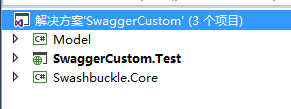
时间: 2016/11/29 18:23:04
本文版权归博客园和作者吴双本人共同所有,转载和爬虫请注明博客园蜗牛原文地址,cnblogs.com/tdws
请原谅我这个标题党,写到了第100篇随笔,说是深度优化,其实也并没有什么深度。源码也没怎么修改,如果你想使用WebApi Swagger文档,请先移步到上一篇的中度优化。
第一篇:ASP.NET WebApi 文档Swagger中度优化 http://www.cnblogs.com/tdws/p/6100126.html
第二篇:ASP.NET WebApi 文档Swashbuckle.Core与SwaggerUI深度定制
1.文档前后端分离
2.项目结构
3.实现分Area(模块)来筛选所需展示的Controller
本篇文章提供源码,下载链接: https://github.com/coderws/CustomSwagger (由于博客园只能上传10MB,就放github上吧,不求star,只为了方便大家下载)
由于Swagger原版的swagger页面和资源js css等文件被嵌入到dll当中,虽然我们可以找到swagger UI的源码,但用起来依然感到有些不便。所以使用了github上另一个开源项目sosoapi,它的文档功能也是基于swagger的,不过为我们做好了一定得拓展,比如现成的中英切换一类的。并且资源完全与之前的嵌入性资源不同,直接分离出来一个swagger UI的文件夹,包括js,css,images,html等等,这样的话,我们修改起来很方便呀,可以做到你想要的定制化,并且我将swagger的后台处理源码down下来,加到解决方案当中,以后遇到问题,再也不用收到dll不能修改和新增功能的困扰。可以将swagger作为你框架中的一部分。

你可以看到Swashbuckle.Core。就是Swagger的后台源码,展开Test项目,其中的Doc文件夹,就是全部的SwaggerUI的内容啦,index.html就是我们的文档首页:

再说Area分组前提一点小的改动
 Required为醒目红色
Required为醒目红色

Swagger 最大宽度增加到1100px,
左侧增加模块筛选,点击筛选后,将只显示对应模块下。
具体的实现方式,就是根据你的模块名称,来筛选api访问路径
如上图第一个user,就代表user模块了,第二个user才是控制器名称。这样的定义,使用了MVC5的新特性RouteAttribute和RoutePrefixAttribute,他们用于在controller中自定义路由,你可以下载源码看到。
那我们左侧菜单栏的数据是哪儿来的呢。请看源码SwaggerConfig中,我定义了这样一个方法:
////// 从API文档中读取控制器描述 /// /// 所有控制器描述 public static ConcurrentDictionary<string, string> GetControllerDesc(HashSet<string> moduleList) { string xmlpath = String.Format("{0}/bin/SwaggerCustom.Test.XML", AppDomain.CurrentDomain.BaseDirectory); ConcurrentDictionary<string, string> controllerDescDict = new ConcurrentDictionary<string, string>(); if (File.Exists(xmlpath)) { XmlDocument xmldoc = new XmlDocument(); xmldoc.Load(xmlpath); string type = String.Empty, path = String.Empty, controllerName = String.Empty; string[] arrPath; int length = -1, cCount = "Controller".Length; XmlNode summaryNode = null; foreach (XmlNode node in xmldoc.SelectNodes("//member")) { type = node.Attributes["name"].Value; if (type.StartsWith("T:")) { //控制器 arrPath = type.Split(''.''); length = arrPath.Length; controllerName = arrPath[length - 1]; if (controllerName.EndsWith("Controller")) { //模块信息 var moduleName = arrPath[length - 2]; moduleList.Add(moduleName); //获取控制器注释 summaryNode = node.SelectSingleNode("summary"); string key = controllerName.Remove(controllerName.Length - cCount, cCount); if (summaryNode != null && !String.IsNullOrEmpty(summaryNode.InnerText) && !controllerDescDict.ContainsKey(key)) { controllerDescDict.TryAdd(key, summaryNode.InnerText.Trim()); } } } } } return controllerDescDict; }
本来这个方法仅用于读取Controller注释的,但是既然这里读取了xml,我也就没必要再读一遍了。我增加了一个HashSet

那么接下来就是要做页面渲染前的筛选工作了。我首先猜测渲染一定和返回json中的path(接口路径)有关,所以我在swagger-ui-ext.js中搜索path,总算找到了结果:
如下所示:遍历时,通过筛选Module模块,对不符合我所想要的module进行直接return,而不向下执行,最终达到想要的目的。之所以说我没有做深度优化的原因也是这里,真正的深度优化应该是在后台代码中所筛选,只返回自己想要的json结果,偷懒了。

所以下图,就是我点击Admin选项后所筛选的结果,该模块下只有两个Controller。

有关我个人所增加的js代码,在Doc/lib/swagger-custom.js中。
//获取Controller描述 function SwaggerCustom() { this.setControllerSummary = function () { $.ajax({ type: "get", async: true, url: $("#input_baseUrl").val(), dataType: "json", success: function (data) { var summaryDict = data.ControllerDesc; var id, controllerName, strSummary; $("#resources_container .resource").each(function (i, item) { id = $(item).attr("id"); if (id) { controllerName = id.substring(9); strSummary = summaryDict[controllerName]; if (strSummary) { $(item).children(".heading").children(".options").prepend(''
使用直接copy走SwaggerConfig.cs和Doc文件放到你项目下,并且引用Swashbuckle就没问题(可以直接拿源码类库,也可以直接从nuget上安装)。并且你想使用这个模块划分的功能,就一定要符合路由规则api/modulename/controller/action.因为模块的筛选就是通过modulename嘛。如果你只想使用swagger的基本功能,看上一篇的分享就足够了。拿到本次分享的源码,你就可以在其中合理的修改源码,自定义你的功能

依然请原谅我这个标题党。
如果我的点滴分享对你有点滴帮助,欢迎点下方红色按钮关注,我将持续输出分享。也欢迎为我,也为你自己点赞。关于本篇源码有任何问题,欢迎留言。